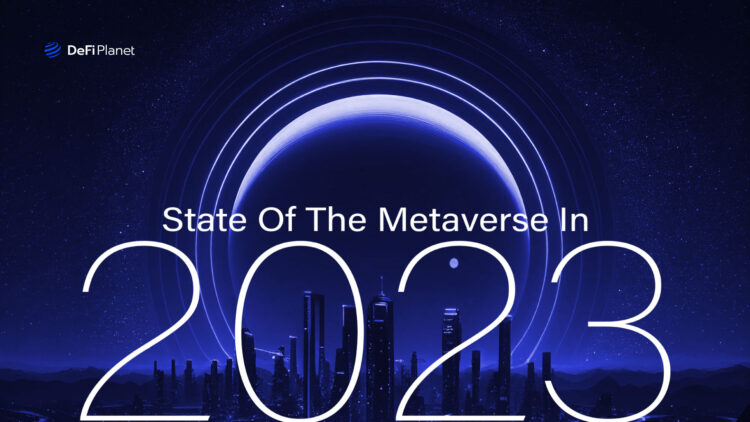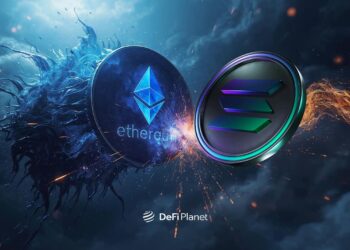Last updated on September 2nd, 2023 at 09:33 am
Following the metaverse boom in 2021, regular and big-shot investors dove headfirst into the industry, all hungry for a slice of the action in this incredible virtual world.
Activities in the metaverse were off the charts, with virtual lands selling for stupendous prices, as high as $4 million, on decentralized apps (dApps) like Decentraland.
Fast forward to 2023; that initial excitement has fizzled out. In fact, funding for metaverse-related projects has taken a nosedive, plummeting by a staggering 99% compared to the same time last year.
While these projects did manage to raise over $700 million in funding, this figure accounts for only about 44% of the total Web3 investments during that time. Not too shabby, but still a far cry from the whopping $1 trillion global market size predicted for 2030.
Now, reading the room, it seems AI’s time to shine, with artificial intelligence projects now stealing the spotlight. It’s quite the plot twist – Meta, a company that used to go on and on about its megabucks investments in the metaverse, has suddenly gone mum about it. Instead, they’ve made a complete U-turn and shifted their focus to AI.
This move has sparked a bunch of discussions and debates within and beyond the Web3 community. Everyone’s asking: Did Meta and the other big players oversell the whole metaverse deal and are now changing lanes?
With all the hype and speculation swirling around, it’s crucial to take a good look at the current state of the metaverse and figure out where it’s all headed.
The Metaverse: 2023 Mid-Year Progress Report
We think of the metaverse as an improvement of the internet thanks in part to Neal Stephenson. When he penned the novel “Snow Crash” in 1992, little did he know that he laid the foundation for what we now recognize as the metaverse — a concept that has evolved from mere buzzword status to become a fundamental aspect of Web3, the internet’s next evolutionary phase.
But how far have we come with this great idea of improving the internet in 2023?
To address this, we will assess progress in two categories: “The Good” and “The Bad”.
“The Good” encompasses events throughout 2023 that have significantly contributed to shaping a promising future for the potential realization of a widespread metaverse experience.
Conversely, “The Bad” includes events that have hindered the advancement and optimistic outlook of the metaverse.
The Good
Traditional Companies’ Sustained Interest in the Metaverse
Traditional brands, from fashion and entertainment companies to the finance sector and tech giants, have shown continued interest in the metaverse.
These brands now have positions for metaverse strategists and other related roles in their openings as the focus on researching how to leverage the metaverse increases.
Prominent brands such as Adidas, Dolce & Gabbana, Diesel, Tommy Hilfiger, and Coach participated in the second edition of Decentraland’s Metaverse Fashion Week (MVFW) in March 2023. These fashion brands showcased how they are using the metaverse to enhance customer experience and reach GenZ audiences on their preferred platforms.
Similarly, Siemens, Europe’s largest manufacturing company, also ramped up its support for developing the industrial metaverse. In July 2023, the corporation allocated €500 million in investments in Germany for industrial metaverse initiatives.
Siemens believes that the success of the metaverse also hinges on the participation of the industries that make up traditional economies and wants to be one of the industries that support the metaverse.
These events, if anything, signal that traditional companies continue to discover how they can use the metaverse to improve their products and services.
Introduction of the Digital Twins Technology
The integration of the metaverse with existing technologies, notably the Internet of Things (IoT) and artificial intelligence (AI), has made considerable progress. One of the results of these integrations is the emergence of the concept of digital twins.
A digital twin is a digital replica of a physical object, such as a person, thing, or organization. This digital representation of physical objects allows for unlimited possibilities for the metaverse. While “digital twins” isn’t entirely a new technology, it has gained increased prominence for use in the metaverse in 2023.
Notably, the partnership between Unreal Engine and PropVR demonstrates how the digital twins technology and the metaverse can enrich experiences within the real estate industry.
This integration leverages Unreal Engine’s metaverse-development suite of tools to create a solution that allows a prospective client to access detailed information about a real estate property within a virtual world that is an exact replica of the actual property.
Innovations like this demonstrate the ability of the metaverse to proffer solutions to real-world problems.
Apple Launches VR Headset
In June 2023, Apple launched the Apple Vision Pro—an impressive virtual reality (VR) headset. This release marked Apple’s biggest product launch since 2015 and sent a clear message: Apple is diving headfirst into shaping the future of the metaverse.
While Apple isn’t explicitly labelling this a metaverse project, the headset’s features align seamlessly with the metaverse’s overarching objectives. Rather than slapping on the metaverse label, Apple is pitching its VR headset as a tool to kick off a brand-new era of spatial computing.
Apple can name its product however it wants, but these big improvements, like making VR, AR, and mixed reality a reality, show that the metaverse is on track to grow and become a part of our lives. These things they’re doing now are like building blocks, turning the idea of a virtual world into something tangible we can experience.
Increased Push for Interoperability
A single party or corporation cannot create a complete metaverse experience; it’s all about bringing together different parties to develop interoperable metaverses. The ultimate goal is to enable you to easily move your owned assets from one metaverse to another without any hassle.
While full interoperability remains a goal yet to be achieved, some positive events in the first half of 2023 indicate that it may happen sooner than expected.
Decentraland’s MVFW for 2023 not only featured the Decentraland metaverse as it did in 2022 but also allowed the event to be hosted on Spatial and Over, two decentralized metaverse/augmented reality platforms.
This expansion improved the experience for attendees and explored the potential of interoperability through Linked Wearables, a type of NFT that permits the use of digital content across different metaverse platforms.
Similarly, The Sandbox partnered with Affyn, a Singapore-based web3 game, to launch an interoperable metaverse that allows users from both virtual games to move their avatars across these platforms.
As research and development into an interoperable metaverse progresses, we can anticipate a metaverse with greater possibilities, where one virtual environment connects to another.
The EU Charts its Course in the Metaverse
On July 11, 2023, the European Commission announced its strategy to promote the development of new technologies, including the metaverse.
The European Commission acknowledged the metaverse as a development with strong growth potential and is conducting research to establish new standards for virtual worlds.
While the Commission aims to ensure the safety of the virtual world, it has recognized the effectiveness of the metaverse in areas such as healthcare, education, art and design, logistics, engineering, and manufacturing.
While there have been a couple of positive events surrounding the metaverse and its related technology in 2023, the entire event hasn’t exactly been rosy.
Now let us talk about the other side of things in the metaverse so far in 2023.
The Bad
Metaverse Crypto Tokens’ Value Decline
Virtual lands and metaverse token owners have faced a challenging year, with significant drops in their assets’ value. Popular decentralized applications (dApps) like Decentraland and The Sandbox have suffered over an 80% drop in the floor price for virtual lands. This has further reduced the overall market valuation of the industry. Metaverse crypto tokens have also witnessed a significant decline, further diminishing the market capitalization of these projects.
Decreased VC Funding
In the first half of 2022, the total investments made into metaverse-related projects add up to about $120 billion. This figure, when compared to the funds raised for metaverse projects during the same period in 2023, signals a 99% decline in funding for metaverse projects.
These numbers indicate that venture capitalists (VCs) have not been particularly confident in investing in the development of the metaverse so far in 2023.
While the bear market does play its role in limiting investors’ confidence, such a significant decline may also reflect the end of the fear of missing out (FOMO) that previously drove investments into metaverse-related projects.
Big Techs’s Slowing Down on the Development of Metaverse-Related Tech
In October 2022, Microsoft formed a team dedicated to developing the industrial metaverse. However, only four months into its operation, the multinational technology corporation laid off the 100 employees in this newly formed Metaverse team.
Meta has also reduced its involvement with the metaverse. According to available information, Meta is estimated to have incurred a total loss of $7.7 billion during the first and second quarters of 2023 and over $30 billion since it initiated its investments in the metaverse.
The company has now dialled back its engagement with the metaverse and redirected its focus toward exploring innovations such as AI.

While both corporations have valid reasons to cut down on their investments in the metaverse, it leaves a sour taste in the industry. Anyone would be concerned if major technology players were to halt investments in technology.
It’s safe to say that the metaverse has been a mix of different events so far in 2023, but where do we go from here? What can we expect in the rest of the year and beyond?
Future Outlook of the Metaverse (The Rest of 2023)
Although the metaverse has not been static in terms of innovative developments and new investments, it is undeniable that its development through the first half of the year has generally slowed down. This situation may, however, represent cutting out the noise and focusing on actual innovation away from the hype.
Newer technologies like artificial intelligence (AI) will be strong contenders for the attention of both venture capitalists (VCs) and end-users in 2023. But this is just one of the many new technologies that will improve the state of the metaverse. More investments into AI may not be so bad for the metaverse. Better AI capabilities will positively affect the metaverse’s usability.
Also, the continued efforts to address issues such as the absence of interoperability among different metaverses have started yielding fruits. Smaller versions of interoperability between separate metaverses are already happening through partnerships. If this trend continues, it will bring the metaverse closer to its goal of being an interconnected virtual world.
Compared to the earlier part of the year, more funding is expected to roll into the industry as the year progresses. Interestingly, this is already starting to happen. Siemens’s €500 million ($562 million) investment into industrial metaverse development represents more than 75% of the entire metaverse investment made in the year’s first half.
We all know that the metaverse has the potential to transform various industries, including gaming, entertainment, education, and commerce. However, it’s important to note that the metaverse, in reality, is a complex and ambitious concept that will require time, collaboration, and innovation from multiple players to reach its full potential.
However, with metaverse dApps like Decentraland and The Sandbox pushing for interoperability and expanding the possibilities within the virtual world, among other innovations around the industry, it’s safe to expect a more positive outlook for the development of the metaverse in the latter part of the year.
Disclaimer: This article is intended solely for informational purposes and should not be considered trading or investment advice. Nothing herein should be construed as financial, legal, or tax advice. Trading or investing in cryptocurrencies carries a considerable risk of financial loss. Always conduct due diligence.
If you would like to read more articles like this, visit DeFi Planet and follow us on Twitter, LinkedIn, Facebook, Instagram, and CoinMarketCap Community.
“Take control of your crypto portfolio with MARKETS PRO, DeFi Planet’s suite of analytics tools.”





















